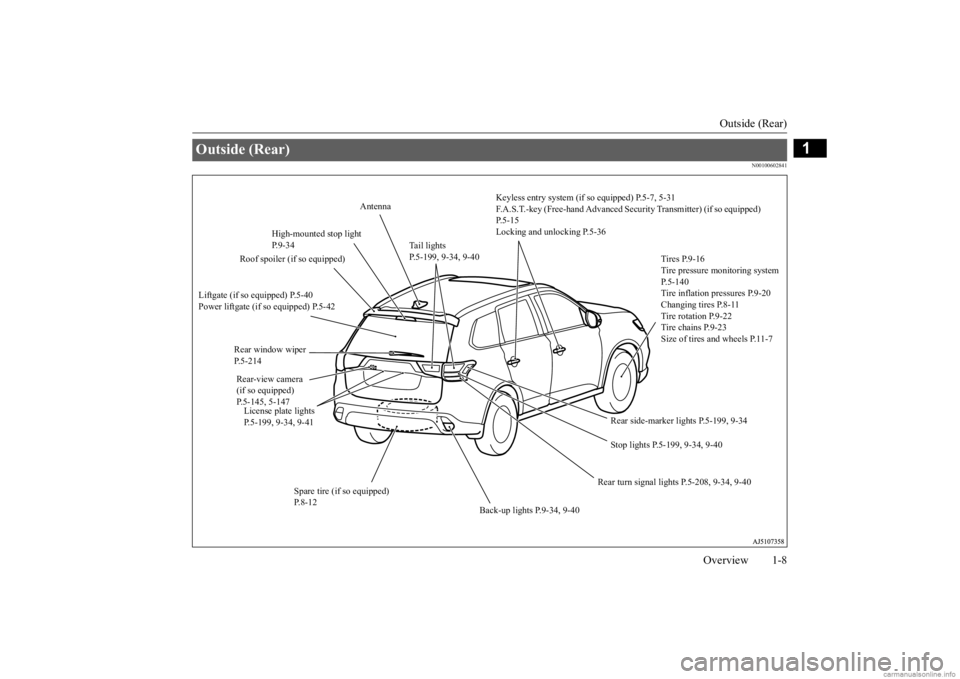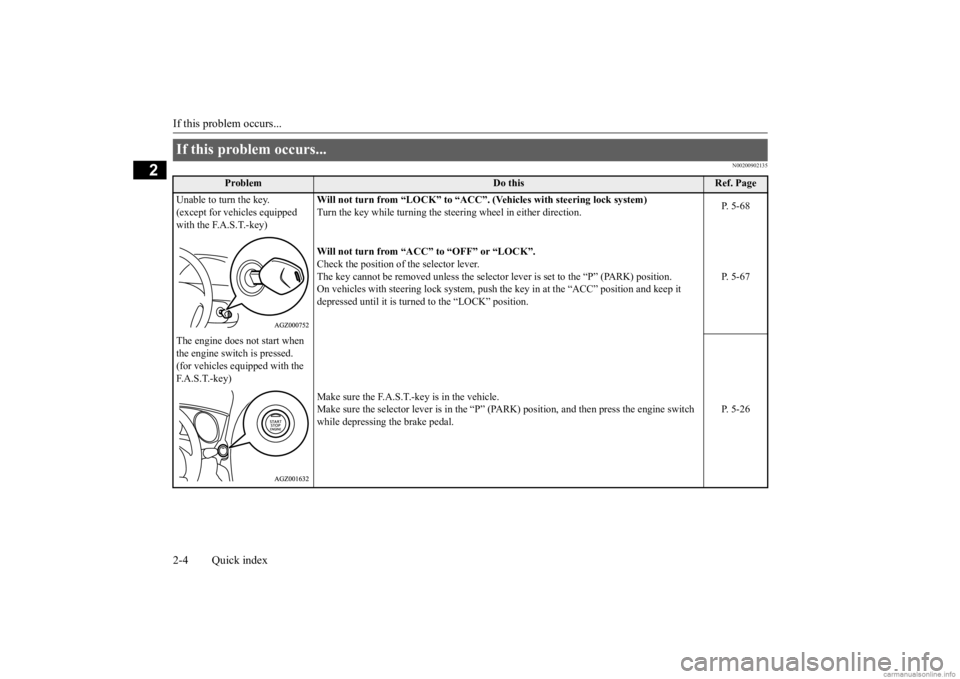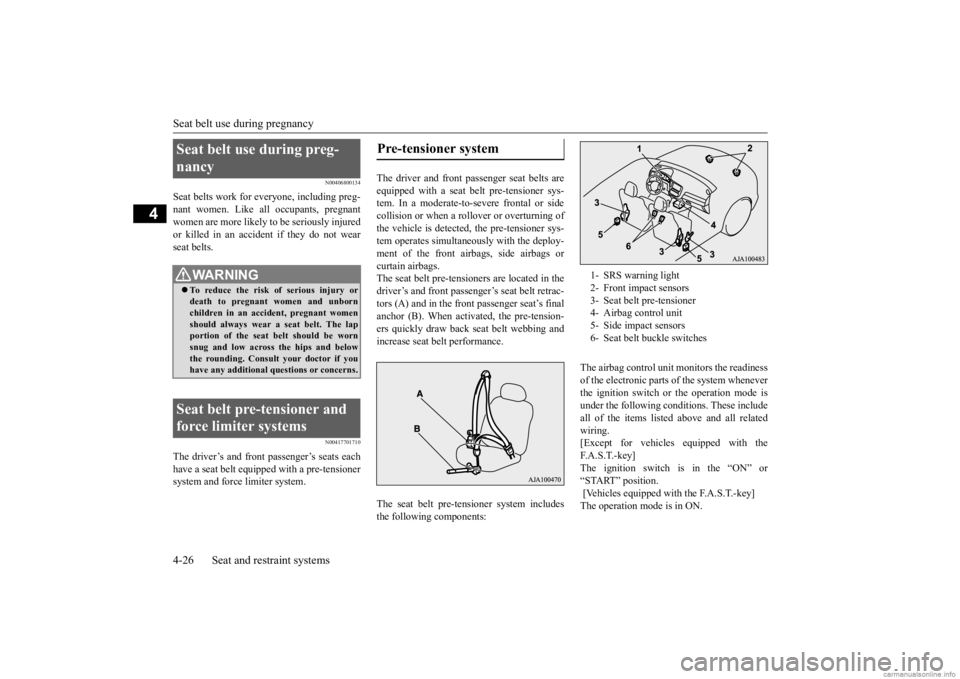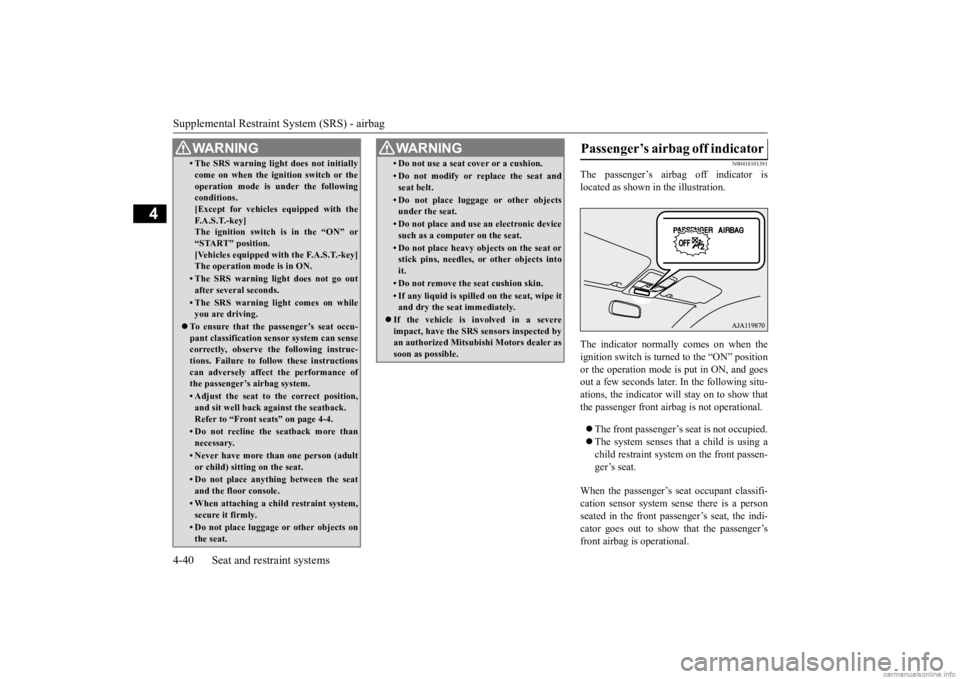2020 MITSUBISHI OUTLANDER key
[x] Cancel search: keyPage 6 of 443
![MITSUBISHI OUTLANDER 2020 Owners Manual (in English) Instruments and controls
Overview 1-2
1
Audio (if so equipped) [Refer to the separate owner’s manual.] Multi Around Monitor (if
so equipped) P.5-147
Hazard warning flasher switch P.5-209
Electr MITSUBISHI OUTLANDER 2020 Owners Manual (in English) Instruments and controls
Overview 1-2
1
Audio (if so equipped) [Refer to the separate owner’s manual.] Multi Around Monitor (if
so equipped) P.5-147
Hazard warning flasher switch P.5-209
Electr](/manual-img/19/34860/w960_34860-5.png)
Instruments and controls
Overview 1-2
1
Audio (if so equipped) [Refer to the separate owner’s manual.] Multi Around Monitor (if
so equipped) P.5-147
Hazard warning flasher switch P.5-209
Electric rear window defogger switch P.5-216 Wiper deicer switch (if so equipped) P.5-215
Fuel tank filler door release lever P. 3 - 3
Air conditioner P.7-5 Hood release lever P. 9 - 3
Floor console box P.5-233 Arm rest 12 V power outlet (if so equipped) P.5-221USB input terminal (if so equipped) P.5-218
Cup holder P.5-235
12 V power outlet P.5-221
Power liftgate main switch (if so equipped) P.5-43
Key slot (if so equipped) P.5-28
Passenger’s vents P. 7 - 2
Heated steering wheel switch (if so equipped) P.5-217
Blind Spot Warning (BSW) switch (if so equipped) P.5-127
USB input terminal (if so equipped) P.5-218
USB input terminal P.5-218
2nd seat vents (if so equipped) P. 7 - 2
USB port (for charging) (if so equipped) P.5-222
ECO mode switch P.5-209
BK0278200US.book 2 ページ 2019年4月10日 水曜日 午前10時59分
Page 12 of 443

Outside (Rear)
Overview 1-8
1
N00100602841
Outside (Rear)
Keyless entry system (if so equipped) P.5-7, 5-31 F.A.S.T.-key (Free-hand Advanced Se
curity Transmitter) (if so equipped)
P.5-15 Locking and unlocking P.5-36
Tires P.9-16 Tire pressure monitoring system P.5-140Tire inflation pressures P.9-20Changing tires P.8-11 Tire rotation P.9-22 Tire chains P.9-23Size of tires and wheels P.11-7
Stop lights P.5-199, 9-34, 9-40
Rear turn signal lights P.5-208, 9-34, 9-40
Spare tire (if so equipped) P.8-12
Back-up lights P.9-34, 9-40
License plate lights P.5-199, 9-34, 9-41 Rear-view camera (if so equipped) P.5-145, 5-147 Rear window wiper P.5-214
High-mounted stop light P.9-34
Antenna
Liftgate (if so equipped) P.5-40 Power liftgate (if so equipped) P.5-42
Rear side-marker lights P.5-199, 9-34
Tail lights P.5-199, 9-34, 9-40
Roof spoiler (if so equipped)
BK0278200US.book 8 ページ 2019年4月10日 水曜日 午前10時59分
Page 17 of 443

If this problem occurs... 2-4 Quick index
2
N00200902135
If this problem occurs...
Problem
Do this
Ref. Page
Unable to turn the key. (except for vehicles equipped with the F.A.S.T.-key)
Will not turn from “LOCK” to “ACC”.
(Vehicles with steering lock system)
Turn the key while turning the st
eering wheel in either direction.
P. 5-68
Will not turn from “ACC” to “OFF” or “LOCK”. Check the position of the selector lever. The key cannot be removed unle
ss the selector lever is set
to the “P” (PARK) position.
On vehicles with steering lock system, push
the key in at the “ACC” position and keep it
depressed until it is turned to the “LOCK” position.
P. 5-67
The engine does not start when the engine swit
ch is pressed.
(for vehicles equipped with the F. A . S . T. - k e y )
Make sure the F.A.S.T.-key is in the vehicle. Make sure the selector lever is in the “P” (PAR
K) position, and then pr
ess the engine switch
while depressing the brake pedal.
P. 5-26
BK0278200US.book 4 ページ 2019年4月10日 水曜日 午前10時59分
Page 18 of 443

If this problem occurs...
Quick index 2-5
2
The engine does not start and the operation mode cannot be changed to OFF. (for vehicles equipped with the F.A.S.T.-key)
1. Move the selector lever to the “P” (PARK)
position, and then cha
nge the operation mode
to OFF.2. One of the other causes could be low battery voltage. If this occurs, the keyless entry system, the
F.A.S.T.-key operation
and the steering wheel
lock (if so equipped) will also not operate
. Contact an authorized Mitsubishi Motors
dealer.
P. 5-20
The F.A.S.T.-key does not oper- ate.(for vehicles equipped with the F. A . S . T. - k e y )
Insert the F.A.S.T.-key into the key slot of the instrument panel, and then start the engine or change the operation mode. Use the emergency
key to lock and unlock the driver’s door.
P. 5-28, 5-29
Cannot shift the selector lever from the “P” (PARK) position.
Shift the selector lever while pressing the brake pedal. Check that the ignition switch or
the operation mode is in ON.
P. 5-70, 5-77
The windows are fogged up.
Push the defogger switch to change to the “ ” position.
P. 7-9
The engine does not start. The lights do not come on. The lights are dim. The horn does not honk.The horn sound is weak.
Have the battery checked. Rech
arge or replace as needed.
P. 8-2, 9-14
Problem
Do this
Ref. Page
BK0278200US.book 5 ページ 2019年4月10日 水曜日 午前10時59分
Page 51 of 443

Seat belts 4-22 Seat and restraint systems
4
1. Pull out the detachable anchor from the storage pocket on se
at back cushion.
2. Pull out the small la
tch plate (A) and then
pull out the latch plat
e (B) by tilting it as
shown in the illustration.
3. Pull the small latch plate (A) slowly and insert it into the detachable anchor (C)until a click is heard. Make sure that the seat belt is not twisted.
1. While holding the seat
belt, insert a metal
plate, such the latch
plate of the seat belt
or a key, into the slit (E) on the detachable anchor (C) and release
the center seat belt
from the detachable anchor. 2. Retract the seat belt slowly by holding the seat belt.
To attach
NOTE
Pulling out the latch plate by force may dam- age the headliner.
NOTE
If the seat belt lock
s up and cannot be pulled
out, pull it once with fo
rce and let it retract
all the way.Then, pull the belt out
slowly once again.
The seat belt can be
buckled up by inserting
the latch plate (B) into the buckle (D) like other seat belts. If the seat belt switch to the ALR child restraint installation
function and cannot be
pulled out, detach the latch plate (B) andmove the second row seat fully backward. Refer to “Installing a child restraint system using the seat be
lt” on page 4-32.
To d e t a c h
NOTE
If the seat belt is not held, the seat belt will rapidly retract. This
could cause damage to
the interior trim.
BK0278200US.book 22 ページ 2019年4月10日 水曜日 午前10時59分
Page 55 of 443

Seat belt use during pregnancy 4-26 Seat and restraint systems
4
N00406800134
Seat belts work for
everyone, including preg-
nant women. Like al
l occupants, pregnant
women are more likely to be seriously injuredor killed in an accide
nt if they do not wear
seat belts.
N00417701710
The driver’s and front passenger’s seats each have a seat belt equippe
d with a pre-tensioner
system and force limiter system.
The driver and front pa
ssenger seat
belts are
equipped with a seat
belt pre-tensioner sys-
tem. In a moderate-to-severe frontal or sidecollision or when a rollover or overturning of the vehicle is detected
, the pre-tensioner sys-
tem operates simultane
ously with the deploy-
ment of the front airb
ags, side airbags or
curtain airbags. The seat belt pre-tensioners are located in the driver’s and front passe
nger’s seat belt retrac-
tors (A) and in the front passenger seat’s finalanchor (B). When activated, the pre-tension- ers quickly draw back seat belt webbing and increase seat belt performance. The seat belt pre-tensioner system includes the following components:
The airbag control unit monitors the readiness of the electronic parts of the system whenever the ignition switch or the operation mode is under the following condi
tions. These include
all of the item
s listed above a
nd all related
wiring. [Except for vehicles equipped with theF. A . S . T. - k e y ] The ignition switch is in the “ON” or “START” position. [Vehicles equipped with the F.A.S.T.-key] The operation mode is in ON.
Seat belt use during preg- nancy
WA R N I N G To reduce the risk of serious injury or death to pregnant women and unborn children in an accident, pregnant womenshould always wear
a seat belt. The lap
portion of the seat belt should be worn snug and low across the hips and belowthe rounding. Consult your doctor if you have any additional qu
estions or concerns.
Seat belt pre-tensioner and force limiter systems
Pre-tensioner system
1- SRS warning light 2- Front impact sensors 3- Seat belt pre-tensioner 4- Airbag control unit5- Side impact sensors 6- Seat belt buckle switches
BK0278200US.book 26 ページ 2019年4月10日 水曜日 午前10時59分
Page 67 of 443

Supplemental Restraint System (SRS) - airbag 4-38 Seat and restraint systems
4
N00407801659
The SRS includes the following components:
The airbag control unit monitors the readiness of the electronic parts of the system whenever the ignition switch or the operation mode is under the following condi
tions. These include
all of the item
s listed above a
nd all related
wiring.[Except for vehicles equipped with the F. A . S . T. - k e y ] The ignition switch is in the “ON” or“START” position. [Vehicles equipped with the F.A.S.T.-key] The operation mode is in ON. The airbags will operate under the same con- ditions as the airbag control unit.
WA R N I N G FRONT-FACING CHILD RESTRAINT SYSTEMS should be used in the rear seatwhenever possible. If they must be used inthe front passenger se
at, move the seat to
the most rearward po
sition and make sure
the child stays in the child restraint sys-tem, properly restrained. Failure to follow these instructions could result in serious injury or death to the child.WA R N I N G Older children should be seated in the rear seat with thei
r seat belt properly
worn, and with an
appropriate booster
seat if needed. Refer to “Children
who have outgrown
child restraint systems” on page 4-34.
How the Supplemental Restraint System works 1- Airbag module (Driver) 2- Passenger’s airb
ag off indicator
3- SRS warning light 4- Airbag module (Passenger)5- Side airbag modules 6- Driver’s seat position sensor 7- Passenger’s seat oc
cupant classifica-
tion sensor system
8- Airbag module (Driver’s knee) 9- Airbag control unit
10- Curtain airbag modules11- Front impact sensors12- Side impact sensors
BK0278200US.book 38 ページ 2019年4月10日 水曜日 午前10時59分
Page 69 of 443

Supplemental Restraint System (SRS) - airbag 4-40 Seat and restraint systems
4
N00418101391
The passenger’s airbag off indicator is located as shown in
the illustration.
The indicator normally comes on when the ignition switch is turned to the “ON” position or the operation mode is put in ON, and goesout a few seconds later.
In the following situ-
ations, the indicator will stay on to show that the passenger front airb
ag is not operational.
The front passenger’s seat is not occupied. The system senses that a child is using a child restraint system on the front passen- ger’s seat.
When the passenger’s seat occupant classifi- cation sensor sy
stem sense there is a person
seated in the front passenger’s seat, the indi- cator goes out to show that the passenger’sfront airbag is operational.
• The SRS warning light does not initially come on when the ignition switch or theoperation mode is under the followingconditions. [Except for vehicles equipped with the F. A . S . T. - k e y ]The ignition switch is in the “ON” or “START” position. [Vehicles equipped with the F.A.S.T.-key]The operation mode is in ON.• The SRS warning light does not go outafter several seconds.• The SRS warning li
ght comes on while
you are driving.
To ensure that the passenger’s seat occu- pant classification sensor system can sense correctly, observe the following instruc- tions. Failure to follow these instructionscan adversely affect
the performance of
the passenger’s airbag system.• Adjust the seat to the correct position,and sit well back
against the seatback.
Refer to “Front seats” on page 4-4.• Do not recline the seatback more thannecessary.• Never have more than one person (adultor child) sitting
on the seat.
• Do not place anything between the seat and the floor console.• When attaching a chil
d restraint system,
secure it firmly.• Do not place luggage or other objects onthe seat.WA R N I N G
• Do not use a seat cover or a cushion.• Do not modify or re
place the seat and
seat belt.• Do not place luggage or other objectsunder the seat.• Do not place and use
an electronic device
such as a computer on the seat.• Do not place heavy obje
cts on the seat or
stick pins, needles, or other objects into it.• Do not remove the seat cushion skin.• If any liquid is spille
d on the seat, wipe it
and dry the seat immediately.
If the vehicle is involved in a severe impact, have the SRS sensors inspected by an authorized
Mitsubishi Motors dealer as
soon as possible.WA R N I N G
Passenger’s airbag off indicator
BK0278200US.book 40 ページ 2019年4月10日 水曜日 午前10時59分